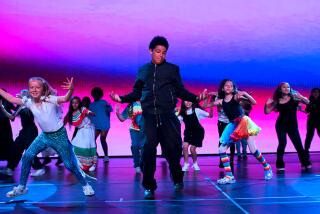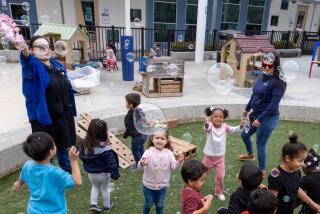PARENTING : Beyond the Basics : As schools trim physical education and art programs, parents look to outside classes to allow children to explore new interests, talents.
- Share via
In theory, choosing after-school activities for children should be fun and easy, but parents say it’s hard to know how structured a child’s time off should be, and just what sorts of programs are most worth while.
One thing is clear: Since tight-budgeted schools have greatly reduced the number of physical education and arts classes they offer, moms and dads are increasingly using after-school hours to provide youngsters with opportunities to explore new interests or develop special talents.
According to Barbara Polland, professor of child development at Cal State Northridge, most extracurricular activities contribute positively to a child’s attitude about learning and life, and stimulate parts of the brain that straight academic programs cannot.
Succeeding in an art class or a poetry club can raise children’s self-esteem, allowing them to build on strengths and feel the pleasure of doing something well.
Such successes can later spill over into academic course work, Polland said.
Though there are a host of factors that determine which activities a youngster undertakes, Polland believes that the child’s interests should be a major influence.
“Wherever the child shows more enthusiasm--that’s the most important clue about what to pursue,” she said. “If a child has a true propensity, you generally can’t keep them away from it.”
More commonly, kids are swayed by what their friends are doing. “If you insist on giving your child tennis lessons because that is what you always wish you did, but all your child’s friends are in T-ball, your kid will resent you,” Polland cautioned.
*
Sometimes parents enroll their children in an activity because they are convinced the child shows natural--or supernatural--talent. “Most people tell me their children are very artistic and talented when they enroll,” said Donna Meyers, a teacher at Mission Renaissance Art Classes in Sherman Oaks.
In fact, she added, most of the children are not unusually talented, but they like art, so they do well.
Polland warns parents against pushing a child to pursue an activity because they see signs of impressive talent.
“Only a tiny fraction of society is really gifted in any area. And even if the child is especially talented, when you push kids, they burn out, whether it’s gymnastics, or swimming, ballet, karate, computers or anything else,” she said.
Whatever a child’s interests or abilities, some teachers suggest that parents try to arrange an introductory class before signing up for a full-length course, an option many schools offer routinely.
At Mission Renaissance Art Classes, for example, children are given a free 1 1/2-hour preview to see if they and their parents like the approach and the teacher, said Meyers.
Meyers suggests that parents initially look for classes that teach basics. In art, for example, she recommends courses that help children learn to look at objects carefully--to study the shapes inherent in everything--and convey the fundamentals of drawing and painting.
Teachers also encourage parents to find instructors who communicate to children the idea that they can do anything if they want to, if they practice the skill enough. “Look for a program that really cares, where the teacher is willing to get involved with the children,” said Meyers.
The ultimate goal in after-school activities is to give children a chance to explore, to have fun, and to succeed, these experts agree.
“I have a little boy in one class who calls his art ‘miracle pictures,’ ” said Meyers. “It gives him great confidence to know there’s really something he can do well.”






